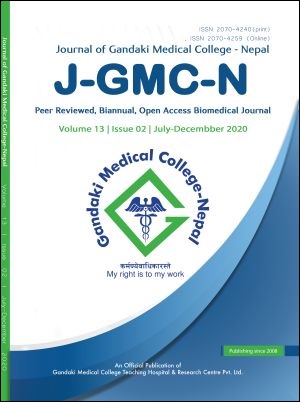Clinical and laboratory profile of dengue fever in children from a tertiary care centre of Gandaki Province, Nepal
DOI:
https://doi.org/10.3126/jgmcn.v13i2.30649Keywords:
Severe dengue, Thrombocytopenia, Warning signs, WHOAbstract
Introduction: Dengue, the arthropod borne viral disease is serious public health problem in Nepal. The clinical diagnosis of dengue has become challenging in children as it is presented with nonspecific symptoms. The objective of present study was to assess different clinical presentations and outcomes of dengue fever in tertiary care centre.
Methods: A record based observational cross-sectional study was carried out on all dengue positive patients of aged 11 months to 15 years presented in Gandaki Medical College from July to November 2019. Total 74 patients with history of fever with dengue seropositive were included in the study. All the clinical and haematological findings were recorded in semi-structured questionnaire form.
Results: Of 74 patients 40 (54.1%) males and 34 (45.9%) were females. Fiftyone (68.9%) were cases of dengue without warning sign, 18 (24.3%) were dengue with warning signs and 5(6.8%) cases had severe dengue symptoms. Most of the patients (78.38%) were from Kaski district. Fever (100%) was the most common clinical presentation followed by headache (36.5%), vomiting (25.7%), and retro orbital pain (20.3%). Common laboratory findings included thrombocytopenia (59.4%) and leukopenia (35.1%). Among 74 cases, 68 were in stable condition and treated in OPD or in ward, and 6 were admitted in ICU of which one developed warning signs and other 5 had severe dengue. All the enrolled children recovered well and there was no mortality during this period.
Conclusions: Fever, headache, vomiting, thrombocytopenia and leukopenia were most common presentation of dengue fever among children. Appropriate clinico-laboratory diagnosis and management is relatively simple, inexpensive and very effective in saving lives as long as correct and timely interventions are instituted.
Downloads
Downloads
Published
How to Cite
Issue
Section
License
This license allows reusers to distribute, remix, adapt, and build upon the material in any medium or format for noncommercial purposes only, and only so long as attribution is given to the creator.




